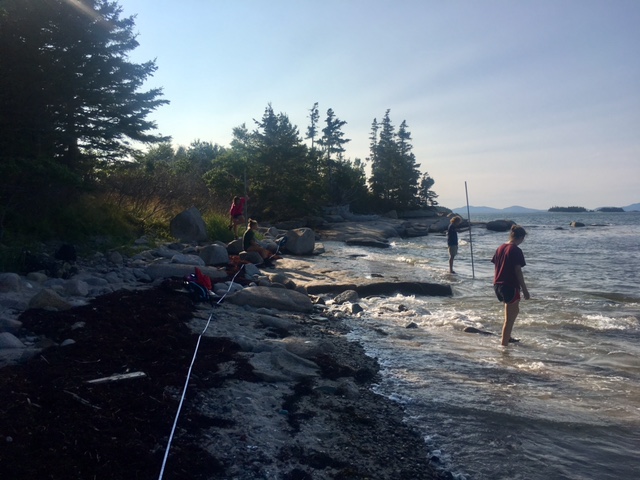Guest blog post by Science Educator Dana Colihan
This year High School Marine Biology set out to do what no program has ever done before--assess the effect of sea level rise on Hurricane Island.
HSMB students taking a break from their work at Sandy Beach
What does Climate Change have to do with Marine Biology? Well, a good heckuva lot. With increasing global temperatures, seas are warming and rising at an exponential rate. NOAA explains the two major causes of sea level rise are the melting of land glaciers and thermal expansion of the oceans. Because water has a higher heat capacity than air, the oceans are absorbing 80 - 90 % of heat from global warming. Warming waters are particularly concerning for Maine’s lobstering industry, potentially driving lobsters further north in search of colder temperatures. Increasing CO2 is also causing ocean acidification. This is concerning for crustaceans, which will have less calcium carbonate available for them to build their shells. While some species might not feel the effects of this for years to come, others have already experienced ocean acidification. The first physical evidence of this was reported in 2012 in the Antarctic with the observation of sea butterflies shells’ dissolving.
High School Marine Biology began their week on Hurricane Island learning about these concepts surrounding the effects of climate change on our oceans. With this knowledge under our belt, we sought to address how climate change could affect Hurricane Island. Using stadia rods, we went to three different sites around the island to map the distance of shoreline lost with two meters of sea level rise. Looking at Valley Cove, two meters of sea level rise would be enough to submerge the perimeter trail. High School Marine Biology calculated that Hurricane Island wouldn’t experience this for another 909 years using the current average rate of sea-level rise in Maine at 2.2 mm/yr. However, using the EPA’s high estimate of future predicted sea level rise, 29 mm/year, the Valley Cove perimeter trail would be submerged in just 69 years.
HSMB students ready to collect data with stadia rods and quadrats
It is important to put this in perspective. While Hurricane Island might not experience extreme shoreline lost anywhere from 69 to 909 years, different communities around the United States are already experiencing the effects of climate change today. High School Marine Biology looked at case studies of a Inupiaq village in Alaska, the Biloxi-Chitimacha-Choctaw people on Isle de Jean Charles in Louisiana, the Wabanaki Confederacy in Maine, as well as communities in Miami, Florida. Many indigenous communities have already been forced to leave their homes and relocate because of sea level rise, and they stand to experience a disproportionate burden of the effects of climate change. In this, High School Marine Biology learned about the injustices of climate change and about concepts of climate justice, the equitable distribution of the burdens of global warming and appropriate involvement of people being affected by climate change in the decision making process.
Focusing on climate change has felt particularly pertinent since the devastation of Hurricane Harvey and Irma. Michael E Mann, a professor of atmospheric science at Pennsylvania State University, argues in his article in the Guardian, that while climate change did not “cause” Hurricane Harvey, climate change exacerbated the damage of the storm.
Students in action in the field!
Climate justice issues are present here too. Dr. Robert Bullard, known as the father of environmental justice, explains in an interview on Democracy Now! that communities of color in Houston have been unequally affected by Hurricane Harvey and climate change. He explains, “…the best predictor of health and well-being in our society, and including Houston, is ZIP Code… Houston’s people of color communities historically have borne the burden for environmental pollution, and also the impact of flooding…this flood in Houston is exacerbating existing disparities…” Dr. Bullard continues, arguing that beyond the flooding, that cleanup and recovery efforts must intentionally include environmental justice, or they will reestablish injustices.
It is imperative to teach students to think about the social impacts of scientific issues because are there are intensely intertwined. Beyond the environmental impacts themselves, who is being affected? Is everyone being affected equally? Is everyone’s voice being heard? While the devastation of Hurricane Harvey and Irma occurred after High School Marine Biology left the Hurricane Island, I am grateful to know that there are 12 incredibly thoughtful, kind, fun, energetic students out there critically thinking about the impacts of global warming on our oceans as well as the injustices of climate change.




